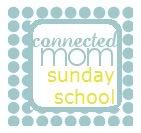 Welcome to the Connected Mom Sunday School. No matter what the course of your child's education, be it unschooling, homeschooling, or conventional schooling, The Connected Mom Sunday School aims to provide you with fun and easy activities for children of all ages and stages. (Have an idea for a Connected Mom Sunday School activity or theme? Either comment below or send your idea to connectedmom (dot) julian (at) gmail (dot) com.)
Welcome to the Connected Mom Sunday School. No matter what the course of your child's education, be it unschooling, homeschooling, or conventional schooling, The Connected Mom Sunday School aims to provide you with fun and easy activities for children of all ages and stages. (Have an idea for a Connected Mom Sunday School activity or theme? Either comment below or send your idea to connectedmom (dot) julian (at) gmail (dot) com.)From understanding day and night to planning out a detailed weekly schedule, your child's understanding of time changes drastically as he grows. For this week's theme, I have found some activities that meet your child on his level and help him grow his understanding of time.
Toddler
Bedtime Board
 Toddlers live in the present. If you want to see this demonstrated, tell your 2-year-old that she can have ice cream later. To her, later might as well mean never. Toddlers cannot understand hours and minutes, but they do have a feel for the the rhythm of life. Simple routines can ease the stress of transitions by cluing your child in to what comes next. Family Fun shares a fun idea for helping her transition from day to night and back again. Cut a piece of cardboard, about 11 x 14 inches (wouldn't an empty cereal box work great for this?). Cut a length of ribbon, about 20 inches, and use a glue stick to attach each end of the ribbon to one of the top corners of the board. Cover one side of the board with dark-colored card stock or construction paper. Cover the other side with light-colored card stock or paper. Attach a picture of your child awake to the "day" side of the board, and a picture of her sleeping to the "night" side. Glue cutouts of a sun, clouds, a moon, and stars to the corresponding sides of the board. Hang it somewhere in your child's room where she can see it easily. When she wakes up in the morning, turn the board to its daytime side. Signal that it's time for bed by turning the board to its nighttime side.
Toddlers live in the present. If you want to see this demonstrated, tell your 2-year-old that she can have ice cream later. To her, later might as well mean never. Toddlers cannot understand hours and minutes, but they do have a feel for the the rhythm of life. Simple routines can ease the stress of transitions by cluing your child in to what comes next. Family Fun shares a fun idea for helping her transition from day to night and back again. Cut a piece of cardboard, about 11 x 14 inches (wouldn't an empty cereal box work great for this?). Cut a length of ribbon, about 20 inches, and use a glue stick to attach each end of the ribbon to one of the top corners of the board. Cover one side of the board with dark-colored card stock or construction paper. Cover the other side with light-colored card stock or paper. Attach a picture of your child awake to the "day" side of the board, and a picture of her sleeping to the "night" side. Glue cutouts of a sun, clouds, a moon, and stars to the corresponding sides of the board. Hang it somewhere in your child's room where she can see it easily. When she wakes up in the morning, turn the board to its daytime side. Signal that it's time for bed by turning the board to its nighttime side.Preschooler
What Comes Next?
Most preschoolers still can't estimate time very well, but they can understand what happens first, next and last. One great way to help your preschooler with sequencing is to follow a set of directions. Diane Flynn Keith of Universal Preschool recommends baking this kid-friendly carrot cake recipe. As indicated in the recipe, have your preschooler help you with peeling the carrots, measuring the dry ingredients, etc. As you work, ask him questions about why you do things in a certain order. For example, why is it important to break the eggs before adding them to the batter? What would happen if you threw in the carrots whole instead of grating them? The goal is not for your child to answer correctly, but to think about the process. Check out the Universal Preschool link above for lots more fun activities to help with sequencing and following directions.
School-Aged Child
How Long Does That Take?
 School-aged kids are now capable of understanding differences in time. Help build your child's concept of time by timing various activities throughout the day. Time how long it takes you to brush your teeth, to walk around the block, or to drive to the grocery store. To hold your child's interest, use a variety of tools for measuring time. Try using a digital clock, an analog clock with a second hand, an hourglass, or a kitchen timer. You can even build your own sundial. Sky & Telescope magazine offers free printable templates (both Northern and Southern versions) and instructions. Practicing measuring time will help your child to visualize how long certain tasks might take, an important time management skill.
School-aged kids are now capable of understanding differences in time. Help build your child's concept of time by timing various activities throughout the day. Time how long it takes you to brush your teeth, to walk around the block, or to drive to the grocery store. To hold your child's interest, use a variety of tools for measuring time. Try using a digital clock, an analog clock with a second hand, an hourglass, or a kitchen timer. You can even build your own sundial. Sky & Telescope magazine offers free printable templates (both Northern and Southern versions) and instructions. Practicing measuring time will help your child to visualize how long certain tasks might take, an important time management skill.Older Child (10+)
A Daily Schedule
Now that your child can read a clock and has a good sense of time, he is ready to put those skills to work in managing his own time. PBS Kids gives a list of tips for kids to make a daily schedule. Have your child draw up a blank schedule with 32 squares--8 across and 4 down. Each block represents one half hour (16 waking hours total). You can also download a blank template from the PBS site. Have him list everything that he needs to do during the day. Then, have him start filling in the squares with things that need to be done at a certain time (for example, music lessons). Then, he can fill in items that can be done at any time--and don't forget to schedule some breaks, too! This activity not only helps with time management, but it helps your child feel ownership of his time.



0 comments:
Post a Comment